These magnificent soft and fluffy cinnamon rolls with cream cheese frosting are the perfect balance of pillowy dough, rich brown sugar and cinnamon swirl, and decadent vanilla cream cheese frosting, making them the ultimate comfort food. I have been testing, perfecting, and enjoying this cinnamon roll recipe for decades, and it is hands down the best ever—soft, fluffy, and utterly irresistible every single time.

Did I mention these are the best cinnamon rolls you will ever eat? These spectacular pastries are perfect for any occasion—a cozy weekend, a holiday breakfast, to reward yourself for getting out of bed in the morning. Who’s counting the calories when you’re living your best life? Not me, friend.
After years of refining this recipe, it’s now the ultimate cinnamon roll masterpiece. Serve these babies up on Christmas morning alongside my Belgian liege waffles and some hot cocoa and you officially win Christmas—forget presents, this is the real holiday magic!
Jump to:
Why You'll Love These Ultimate Soft and Fluffy Cinnamon Rolls
- They’re a Cloud of Cinnamon Bliss. These rolls are so soft and pillowy, you’ll wonder if you’re eating a pastry or a literal dream. Each bite melts in your mouth, with just the right amount of cinnamon-sugar magic swirling through.
- Breakfast or Dessert? Both. Why choose? These cinnamon rolls are perfect for lazy weekend mornings, special celebrations, or treating yourself after a long day.
- They’re Easier Than They Look. Homemade cinnamon rolls sound fancy, but I promise this recipe makes it super doable. If you can roll up a yoga mat, you can roll up these babies.
Ingredients for Soft and Fluffy Cinnamon Rolls
Just a few simple ingredients—flour, sugar, cinnamon, a boatload of butter—will be transformed into breathtaking cinnamon rolls that’ll have you questioning why you ever bothered with anything else in life.

- milk
- active dry yeast
- granulated sugar
- eggs
- butter
- AP flour
- salt
- brown sugar
- cinnamon
- more butter
- cream cheese
- vanilla
- powdered sugar
- even more butter
See recipe card for quantities.
How to Make Homemade Cinnamon Rolls
Don't be intimidated by working with yeast dough—just mix, rise, roll, and let the magic (and cinnamon) do the rest! Seriously, though, I've broken down the steps in detail with helpful hints to guide you through the process.

- In a bowl or liquid measuring cup, combine 1 cup warm milk, 1 tablespoon yeast, and 2 tablespoons sugar. Stir and allow to sit for 5 minutes. If the yeast is good, it will start to bubble and foam.

- In the bowl of a stand mixer fitted with the dough hook, add milk/yeast mixture, butter, eggs, and salt. Mix on medium to combine. The butter may not incorporate completely yet.

- With the mixer on low, add flour in ½-cup increments up to a total of 3-½ cups. Scrape down the sides of the bowl with a spatula as needed (stop the mixer first). If the dough is pulling away from the sides of the bowl and sticking to itself, stop adding flour. Otherwise add flour in ¼-cup increments up to a total of 4 cups with the mixer on low until the dough sticks to itself and is pulling away from the sides of the bowl. It shouldn't be sticky when handled.

- Knead on high for 5 minutes. The dough should be slightly elastic and not sticky. Place in a lightly greased bowl in a warm place, cover with a kitchen towel or plastic wrap, and allow to rise for 1 hour or until doubled. If my kitchen is colder than about 72 F, I will turn my oven on the lowest setting and remove one of the wire racks. Once the oven reaches the lowest temp, turn it off and open the door until the oven feels warm, but not hot. Place the bowl containing the dough in the warm oven to rise.

5. While the dough is rising, mix the cinnamon and brown sugar in a bowl. Set aside.
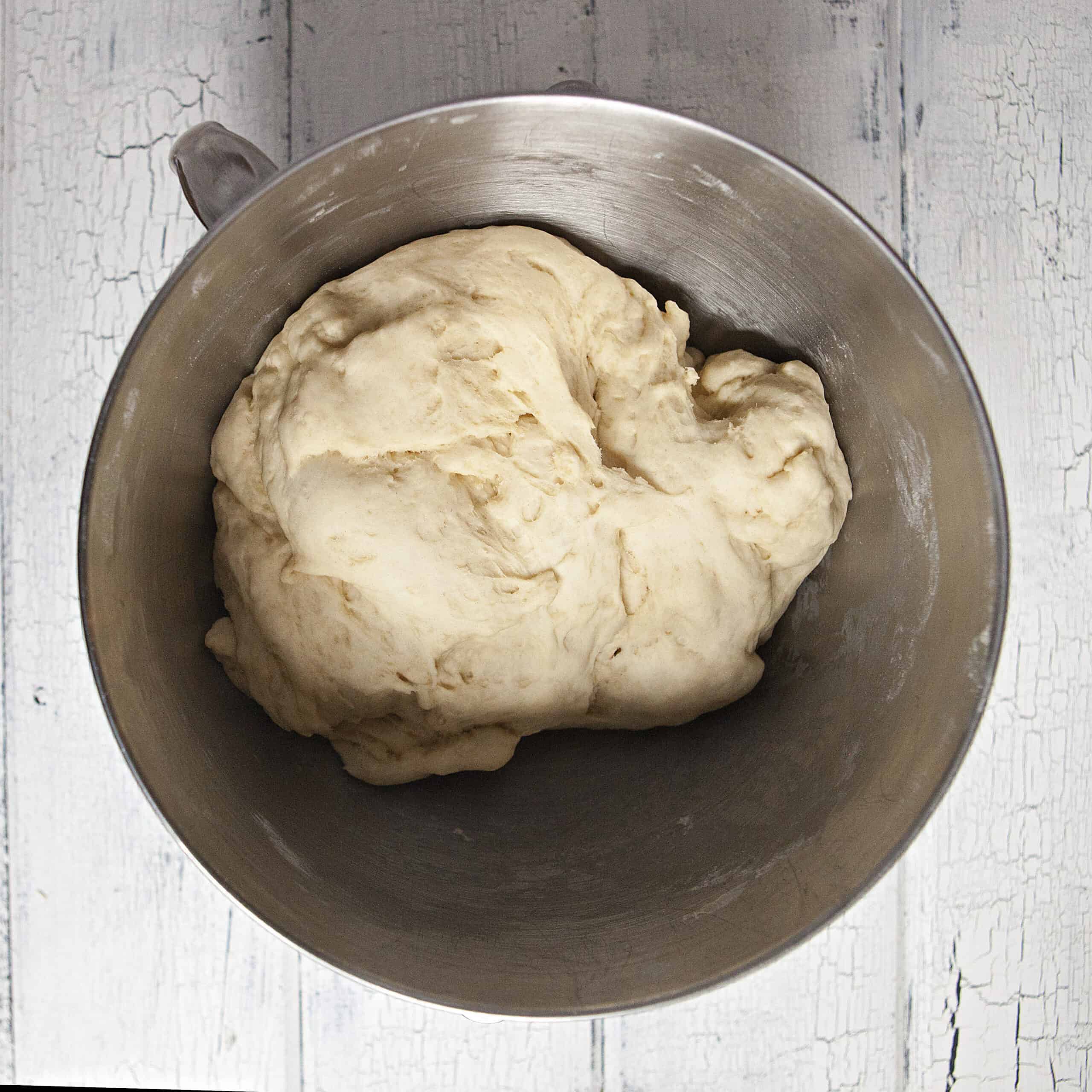
6. After 1 hour of rising, the dough should be doubled in size.

7. Punch down the dough and lightly grease a 13- x 18-inch baking sheet. Use a rolling pin to roll out the dough on the baking sheet to 13 x 18 inches.

8. Spread ½ cup softened butter over the dough.

9. Spread the prepared brown sugar/cinnamon mixture evenly over the top of the buttered dough. Lightly grease a 9x13-inch baking dish.

10. Starting with a long side, roll up the dough as tightly as possible so you have one long roll. This recipe has a LOT of filling, so this step can be a little messy. That's okay! I like to make indentations in the roll at the ¼, halfway, and ¾ mark to use when estimating where to cut the rolls. Use unflavored dental floss or thread or a sharp serrated knife to cut 12 equal rolls (about 1-½ inches each).

11. Place the rolls in the 9x13-inch baking dish. Cover and allow to rise in a warm place for 30-45 minutes OR place in the fridge if you're cooking them the next day. When ready to bake the next day, take rolls out of the fridge and do the second rise (30-45 minutes) before baking as directed.

12. Preheat the oven to 350 F. After the second rise, the rolls should be more puffy and full than before. Place the baking dish in the preheated oven and bake for 25-30 minutes, until the rolls are lightly browned on top and cooked through (not doughy on the bottom). I like to use a spatula to pry a couple of rolls apart and check for doneness.

13. While rolls are cooking, blend 4 tablespoons butter with 4 ounces cream cheese with electric hand mixer until fluffy. You can use a stand mixer for this step with the whisk attachment, but my stand mixer bowl is always dirty from making the dough so I use a separate bowl and electric mixer.

14. Add in 1 to 1-½ cups of powdered sugar, vanilla, and 1-2 tablespoons of milk until you reach the desired frosting consistency. I like mine loose, but not drippy. Beat with mixer until fluffy and smooth.

15. Spread frosting on baked rolls and enjoy! I frost the cinnamon rolls right out of the oven so the icing melts and drips into all of the crevices. YUM!
Hint: If your kitchen isn't super warm and your dough isn't rising well, try my warm oven trick--heat up the oven to the lowest setting, then turn it off. Open the oven door and let some heat dissipate until it's warm, but not hot. Place the covered dough bowl inside the oven. It's perfect for happy dough rising!
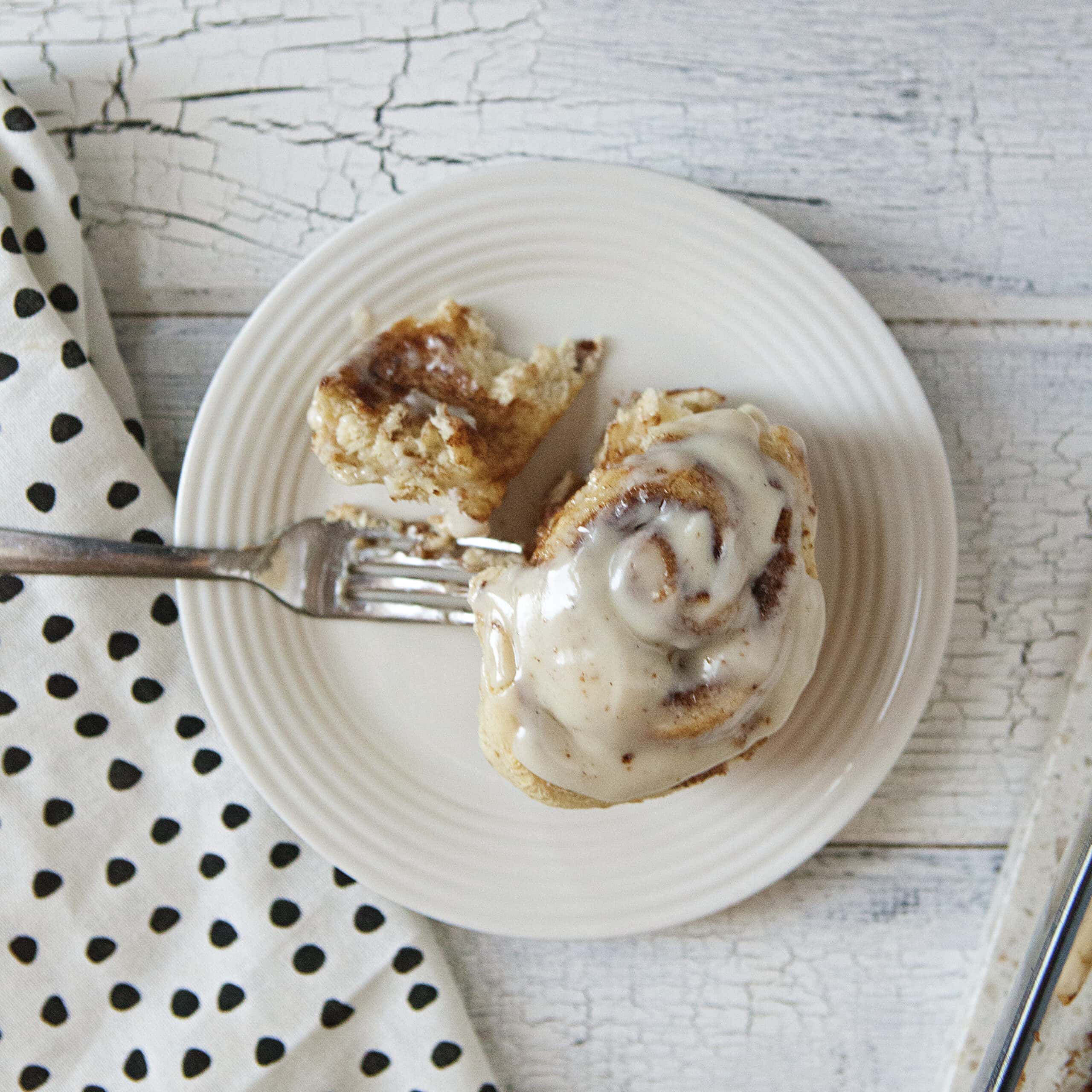
Substitutions
Baking cinnamon rolls is such a fine art I don't advise substituting any major ingredients in this recipe. Check out some ideas for variations below!

Variations
Nothing beats a traditional cinnamon roll with cream cheese frosting, but this recipe is the perfect canvas for flavor experimentation. Try substituting chai spice for the cinnamon for a little extra spicy kick. You can also make a more traditional icing by subbing another 2 tablespoons of butter in place of the cream cheese, or try adding maple, Nutella, or caramel flavor to the frosting.

Equipment
- Mixing bowls – For combining your ingredients.
- Measuring cups and spoons – To ensure the perfect proportions.
- Stand mixer – Optional, but very helpful for kneading the dough.
- Rolling pin – To roll out the dough evenly.
- Sheet pan – I like to use this to help roll the dough to the right size.
- Baking dish – To bake your rolls to golden perfection. I use a 9x13-inch baking dish.
- Kitchen towel or plastic wrap – For covering the dough while it rises.
- Sharp knife or dental floss – For slicing the dough into neat rolls.
- Electric hand mixer – For mixing the frosting ingredients.
- Spatula – To spread frosting on the finished rolls.
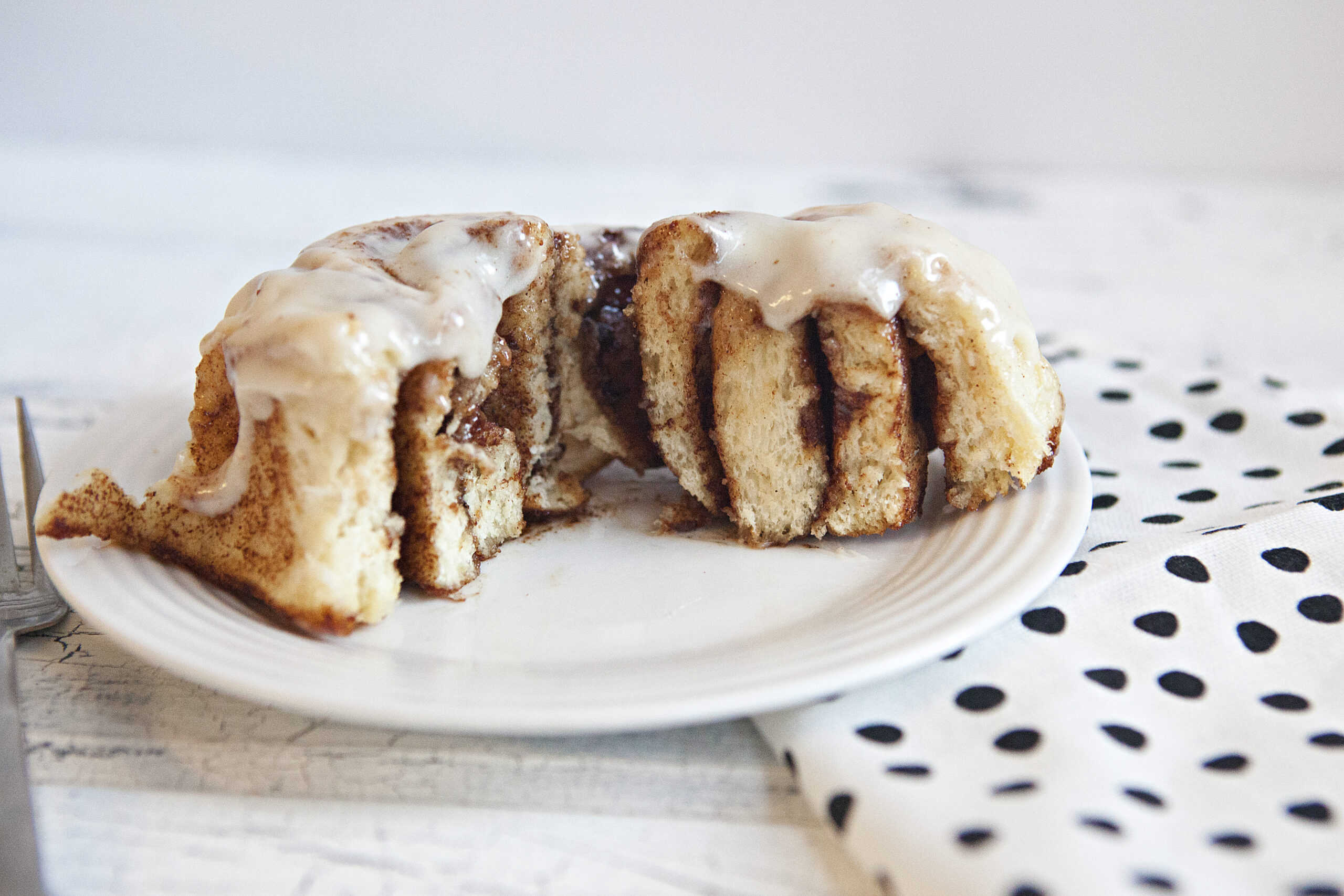
How to Store Cinnamon Rolls
To store cinnamon rolls properly and keep them fresh, follow these steps:
1. Room Temperature (Short-term storage)
- How: Let the cinnamon rolls cool down to room temperature.
- Storage: Store them in an airtight container or wrap them tightly with plastic wrap or aluminum foil.
- Duration: They will stay fresh for 1–2 days at room temperature.
2. Refrigeration (Longer-term storage)
- How: If you want to keep them fresh for a longer period, wrap the cinnamon rolls tightly in plastic wrap or aluminum foil.
- Storage: Place them in an airtight container or resealable plastic bag.
- Duration: They can last up to 5 days in the fridge.
3. Freezing (For extended storage)
- How: Wrap cinnamon rolls in plastic wrap, then place them in a freezer-safe bag or airtight container. I like to freeze the cinnamon rolls without icing and apply the icing after the rolls are reheated to preserve texture.
- Storage: Make sure the rolls are tightly sealed to prevent freezer burn.
- Duration: Cinnamon rolls can be frozen for up to 3 months.
To Reheat:
- Room temperature or fridge-stored rolls: Simply warm them in the microwave for 15–20 seconds or in the oven at 350°F (175°C) for about 5-10 minutes.
- Frozen rolls: Thaw them in the fridge overnight and then reheat as above. Frost as desired.

How to Make Cinnamon Rolls a Day Ahead
To make these cinnamon rolls ahead of time, make the dough, proceed through the first 1-hour rise, roll the dough, cut the rolls, and place them in a baking dish. Instead of doing the second rise, cover and refrigerate the uncooked rolls overnight, then let them rise a second time for about 30-45 minutes before baking as directed.
FAQ
If your dough isn’t rising, it could be due to inactive yeast. Make sure your yeast is fresh and the liquid you’re using is at the right temperature (warm, not hot). Also, give the dough enough time to rise in a warm, draft-free spot.
Use your oven to make a warm spot for the dough to rise. Set your oven to the lowest setting for just a few minutes. Once it reaches that temperature, turn it off. The goal is to create a warm environment without overheating the dough. Open the oven door until the oven feels warm, but not hot. Place the covered bowl of dough inside the oven. The residual heat from the oven will provide a cozy, warm spot for the dough to rise.
Yes! You can prepare the dough, shape it, and refrigerate it overnight. Remove from fridge and let it rise in a warm place for 30-45 minutes before baking the next day.
You can freeze the unbaked rolls after they've been shaped. Cover them tightly with plastic wrap and foil and freeze for up to 3 months. When ready to bake, let them thaw and rise for 1-2 hours before baking. Alternatively, you can freeze baked rolls (without frosting) and reheat them before serving.
You can use regular frosting, but cream cheese frosting gives the cinnamon rolls a rich, tangy, amazing flavor that complements the sweetness of the rolls. It’s highly recommended for the best cinnamon roll experience!
You can prepare the cream cheese frosting in advance and store it in the fridge for up to 3 days. Let it come to room temperature before spreading it on the rolls.
If your frosting is too runny, it might be because the cream cheese or butter was too soft. Try chilling the frosting for a few minutes or adding more powdered sugar to thicken it up.
Make sure to knead the dough properly to develop the gluten and give it time to rise in a warm environment. Also, ensure you're using fresh, active yeast for the best results.
Related
Looking for other recipes like this? Try these:
Pairing
These are my favorite dishes to serve with ultimate soft and fluffy cinnamon rolls with cream cheese frosting:

Ultimate Soft and Fluffy Cinnamon Rolls with Cream Cheese Frosting
Equipment
- mixing bowls for combining your ingredients
- stand mixer optional, but very helpful for kneading the dough
- measuring cups and spoons to ensure the perfect proportions
- Rolling Pin to roll out the dough evenly
- sheet pan I like to use an 18x13-inch sheet pan to roll out the dough
- baking dish I use a 9x13-inch baking dish to bake the cinnamon rolls
- kitchen towel or plastic wrap to cover the dough while it rises
- dental floss or sharp knife for slicing the dough into neat rolls
- electric hand mixer for mixing the frosting ingredients
- spatula to scrape down the sides of the stand mixer bowl when making the dough and to spread frosting on the finished rolls
Ingredients
DOUGH
- 1 cup warm milk
- 1 tablespoon active dry yeast
- 2 tablespoons granulated sugar
- 4 tablespoons butter softened
- 2 eggs
- 1 teaspoon salt
- 3-½ to 4 cups AP flour
FILLING
- ½ cup butter softened
- 1 cup brown sugar
- 3 tablespoons ground cinnamon
FROSTING
- 4 ounces cream cheese softened
- 4 tablespoons butter softened
- 1 teaspoon vanilla
- 1 to 1-½ cups powdered sugar
- 1 to 2 tablespoons milk
Instructions
- In a bowl or liquid measuring cup, combine 1 cup warm milk, 1 tablespoon yeast, and 2 tablespoons granulated sugar. Stir and allow to sit for 5 minutes. If the yeast is good, it will start to bubble and foam.
- In the bowl of a stand mixer fitted with the dough hook, add milk/yeast mixture, butter, eggs, and salt. Mix on medium to combine. The butter may not incorporate completely yet.
- With the mixer on low, add flour in ½-cup increments up to a total of 3-½ cups. Scrape down the sides of the bowl with a spatula as needed (stop the mixer first). If the dough is pulling away from the sides of the bowl and sticking to itself, stop adding flour. Otherwise add flour in ¼-cup increments up to a total of 4 cups with the mixer on low until the dough sticks to itself and is pulling away from the sides of the bowl. It shouldn't be sticky when handled.
- Knead on high for 5 minutes. The dough should be slightly elastic and not sticky.
- Place dough in a lightly greased bowl in a warm place, cover with a kitchen towel or plastic wrap, and allow to rise for 1 hour or until doubled.
- While the dough is rising, mix the cinnamon and brown sugar in a bowl. Set aside.
- After 1 hour of rising, the dough should be doubled in size. Punch down the dough and lightly grease a 13- x 18-inch baking sheet.
- Use a rolling pin to roll out the dough on the baking sheet to 13 x 18 inches. Spread ½ cup softened butter over the dough. Spread the prepared brown sugar/cinnamon mixture evenly over the top of the buttered dough. Lightly grease a 9x13-inch baking dish.
- Starting with a long side, roll up the dough as tightly as possible so you have one long cylinder. Use unflavored dental floss or thread or a sharp serrated knife to cut 12 equal rolls (about 1-½ inches each).
- Place the rolls in the 9x13-inch baking dish. Cover and allow to rise in a warm place for 30-45 minutes.
- Preheat the oven to 350 F. Place the baking dish in the preheated oven and bake for 25-30 minutes, until the rolls are lightly browned on top and cooked through (not doughy on the bottom). If the rolls are browning too much on the top but are not cooked through yet, cover with aluminum foil for the remainder of baking time.
- While rolls are cooking, blend 4 tablespoons butter with 4 ounces cream cheese with electric hand mixer until fluffy. Add in 1 to 1-½ cups of powdered sugar, vanilla, and 1-2 tablespoons of milk until you reach the desired frosting consistency. Beat with mixer until fluffy and smooth.
- Spread frosting on baked rolls and enjoy!



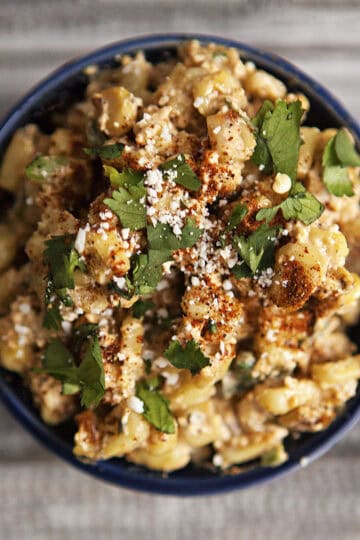

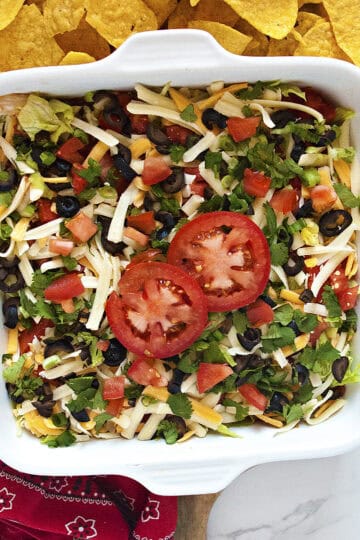





Comments
No Comments